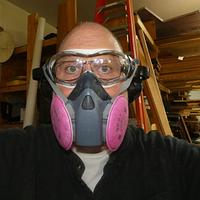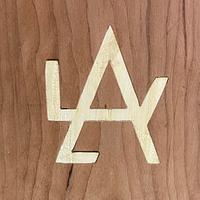Share your craft projects
Make new craft buddies
Ask craft questions
Blog your craft journey

gdaveg
560 posts
and
21 followers
in almost 3 years
in almost 3 years
Good veneer sources
Making carry/serving trays. They will have 2" tall sides bottom 13"x 18.5". Want to use veneer over BB ply for bottoms. First try at veneers.
Would appreciate recommendations for sources to buy from.
Thanks in advance.
Would appreciate recommendations for sources to buy from.
Thanks in advance.
daveg, SW Washington & AZ
19 Replies
I've always gone with veneer supplies but there are plenty of others.
They have periodic sales with discounted shipping which can really help but things have become expensive.
Big fan of their "mystery boxes" as you get a wide variety at a really low price.
If you are looking for just a few pieces, I've also had good luck on ebay.
They have periodic sales with discounted shipping which can really help but things have become expensive.
Big fan of their "mystery boxes" as you get a wide variety at a really low price.
If you are looking for just a few pieces, I've also had good luck on ebay.
I'm a tightwad, and when wood buying be it solid stock, or veneer, plywood I like to put my eyes on whatever I am buying before money changes hands, so long distance dealers have never been where I went.
All I can say is Pre-Covid I used to buy mostly lumber, rare and beautiful, sometimes a bit of veneer from M. Bohlke Veneer Corp, because they are local to me, and had incredible product. Since Covid, either manpower changed, or they decided not to have as much open door selling as they once did, so I don't buy anymore, plus I don't do near the work I used to. Talking to a few who still use them, they still have great stock for sale. Their wood is just incredible quality, color, grain patterns, all the good things you want in wood.
The one place where I still do buy wood that I haven't touched is from Kevin at CurlyMaple wood. His wood is fabulous, BUT it would require you to resaw, he doesn't do veneer. Most of Kevins customers are high end makers, boxes, and other things of beauty, and musical instrument Luthiers. Every one of his boards is sold individually, and there are pics so you don't feel like you are getting a Pig in a Poke. IOW nobody is randomly picking your stock. So much of hos stock ends up as veneer. Something to consider.
Both places cost tons of CASH. So go expecting that.
I may be wrong, but I always thought you were graded by most places as an A through Z buyer, meaning you buy once, you just get what they send you, a Z buyer. You order 3 times a week, and they go looking for PRIMO stuff to send you, an A buyer. I may be wrong, but I've always felt that, and from XYZ companies where I did order wood in the past, it looked to me that is what I got.
All I can say is Pre-Covid I used to buy mostly lumber, rare and beautiful, sometimes a bit of veneer from M. Bohlke Veneer Corp, because they are local to me, and had incredible product. Since Covid, either manpower changed, or they decided not to have as much open door selling as they once did, so I don't buy anymore, plus I don't do near the work I used to. Talking to a few who still use them, they still have great stock for sale. Their wood is just incredible quality, color, grain patterns, all the good things you want in wood.
The one place where I still do buy wood that I haven't touched is from Kevin at CurlyMaple wood. His wood is fabulous, BUT it would require you to resaw, he doesn't do veneer. Most of Kevins customers are high end makers, boxes, and other things of beauty, and musical instrument Luthiers. Every one of his boards is sold individually, and there are pics so you don't feel like you are getting a Pig in a Poke. IOW nobody is randomly picking your stock. So much of hos stock ends up as veneer. Something to consider.
Both places cost tons of CASH. So go expecting that.
I may be wrong, but I always thought you were graded by most places as an A through Z buyer, meaning you buy once, you just get what they send you, a Z buyer. You order 3 times a week, and they go looking for PRIMO stuff to send you, an A buyer. I may be wrong, but I've always felt that, and from XYZ companies where I did order wood in the past, it looked to me that is what I got.
I've not used them but Shipwright recommended Certainly Wood to me a few years back. He likes them because they have thicker veneers available, unlike the paper thin stuff that most places carry. They may have the thin stuff too but I think that he said that he usually uses the 1/16" thickness.
--Nathan, TX. Hire the lazy man. He may not do as much work but that's because he will find a better way.
I’ve ordered from three of the companies mentioned. As George says, CurlyMapleWood has beautiful stuff, but no veneer. But if you’re looking for curly, or torriefied (roasted) maple or sycamore, they’re hard to beat. You can pick exactly which board you’re going to receive, and there’s generally some bonus thrown in the box, as well.
CertainlyWood has beautiful veneer, and you can pick which specific pieces you’re going to get. I have a stack of ash burl veneer from them that will one day become a five foot diameter tabletop, but I need to up my veneer game first. As mentioned, you can pick your thickness, which is helpful.
Veneer Supplies… that’s where I’ve been getting the veneers I’ve been practicing with. I got two sampler packs / mystery boxes, and it’s a great price for good veneer, but it’s almost all been thin stuff. 1/42” IIRC. But for a beginner practicing? Go for it. Buy a couple mystery packs and knock yourself out.
CertainlyWood has beautiful veneer, and you can pick which specific pieces you’re going to get. I have a stack of ash burl veneer from them that will one day become a five foot diameter tabletop, but I need to up my veneer game first. As mentioned, you can pick your thickness, which is helpful.
Veneer Supplies… that’s where I’ve been getting the veneers I’ve been practicing with. I got two sampler packs / mystery boxes, and it’s a great price for good veneer, but it’s almost all been thin stuff. 1/42” IIRC. But for a beginner practicing? Go for it. Buy a couple mystery packs and knock yourself out.
May you have the day you deserve!
The thin stuff is pretty easy to hammer down with hot hide glue in my experience.
--Nathan, TX. Hire the lazy man. He may not do as much work but that's because he will find a better way.
The thin stuff is pretty standard sizing for veneer, ideal for using over BB or other panel material plus it can be bent fairly easily.
Thicker is great if you plan on a lot of sanding or have other reasons for it.
Thicker is great if you plan on a lot of sanding or have other reasons for it.
When I have done veneer in the past it was also doing hammer veneering with hot hide glue. Very easy to do, and totally reversible. A long time ago Rob showed me how to repair the thinner veneers, and it's not hard. Plenty on both online, and hammer veneering is the quickest way to get into veneering, and does NOT require expensive equipment to start with. IE: Pressure bags, pumps, yada yada... Some hot hide glue and a strong wooden squeegee get you going.
Veneer hammers, usually under $100.00 most around $59.00 You can however roll your own, similar to making a mallet just a thinner edge. Instead of pounding, you do more of a scraping action, pulling the veneer flat, so it can nest to the glue. Hide glue is what you make it, but 90+% of the folks I know starting out used a Fondue pot they picked up at an auction for 5 bux or less, and a sack of hot hide glue pellets. Here Joel offers a quick primer on glue uses, for different kinds of work. That is maybe the hardest thing, is knowing which glue is best for what work.
Beyond that I totally agree with Dave. Pick up a few sampler packs, and a few sheets of MDF, cut the MDF into workable pieces, and go nutz. From what I have experienced, and observed in others, trying to start out doing a boardroom sized tabletop is a recipe for disaster. Instead learn on smallish box sides, little stuff that you can get cutting, and laying down to really manageable sizes, and build up from there. It ain't rocket science. back when it was often done by untrained, barely schooled folks who wanted something special. BUT it does require following some sensible steps to order the work, so you don't end up with a gloopy, sticky, wad.
Veneer hammers, usually under $100.00 most around $59.00 You can however roll your own, similar to making a mallet just a thinner edge. Instead of pounding, you do more of a scraping action, pulling the veneer flat, so it can nest to the glue. Hide glue is what you make it, but 90+% of the folks I know starting out used a Fondue pot they picked up at an auction for 5 bux or less, and a sack of hot hide glue pellets. Here Joel offers a quick primer on glue uses, for different kinds of work. That is maybe the hardest thing, is knowing which glue is best for what work.
Beyond that I totally agree with Dave. Pick up a few sampler packs, and a few sheets of MDF, cut the MDF into workable pieces, and go nutz. From what I have experienced, and observed in others, trying to start out doing a boardroom sized tabletop is a recipe for disaster. Instead learn on smallish box sides, little stuff that you can get cutting, and laying down to really manageable sizes, and build up from there. It ain't rocket science. back when it was often done by untrained, barely schooled folks who wanted something special. BUT it does require following some sensible steps to order the work, so you don't end up with a gloopy, sticky, wad.
Dave, I'm becoming smitten with Kevin's Curly Black Walnut. He has been trying to source more of it, but Curly Maple look on Walnut is something to see when the finish goes on. Those alternating grains just light up. Similar to how dyed Curly Maple does, striking contrast. My Wife loves Kevin, and we buy wood for bottoms for her baskets that start off a wooden base, the Curly Walnut against white/tan colored reed just jumps up.
He has a stick he wants 1500 bux for, and it is like Cocaine to a crackhead, drawing me in.... :-) I can imagine slicing that down to some thin slabs, and making something great. At 16" wide, it's probably gonna go to a guitar skin, while I try to whittle him down on price.
He has a stick he wants 1500 bux for, and it is like Cocaine to a crackhead, drawing me in.... :-) I can imagine slicing that down to some thin slabs, and making something great. At 16" wide, it's probably gonna go to a guitar skin, while I try to whittle him down on price.
Yeah. The big thing I’ve had trouble with here is things drying out on me too fast. I wet the veneer, get it flattened, it’s dry again. Wet it again, it curls some, apply glue, get the veneer down, dry again. But then this is the driest time of the year here, and I’m still learning, so I end up stopping and thinking at inopportune times.
That is pretty, George. But I’m at a point where I haven’t even made a run to buy more pine for shop furniture. Behind on multiple projects, and still haven’t finished processing the truckload of pine and oak I brought back from MN last year. I need to work down the inventory a bit before I buy any more lumber at this point.
That is pretty, George. But I’m at a point where I haven’t even made a run to buy more pine for shop furniture. Behind on multiple projects, and still haven’t finished processing the truckload of pine and oak I brought back from MN last year. I need to work down the inventory a bit before I buy any more lumber at this point.
May you have the day you deserve!
Dave, are you applying the HHG to the substrate and both sides of the veneer? When you say it dries do you mean it starts to gel? If so, temperature may be more of an issue than the humidity.
--Nathan, TX. Hire the lazy man. He may not do as much work but that's because he will find a better way.
Yeah, Nathan. And it may be temp. My cheap little water bath isn’t hot, so much as warm. It holds 140F pretty reliably, but I may need something warmer.
But I run into trouble with things like wetting the veneer to get the wrinkles out, and by the time I’m done and start applying glue to the substrate, the veneer is drying out (and wrinkling) again already. I almost feel like I should set up a bath for it.
But I run into trouble with things like wetting the veneer to get the wrinkles out, and by the time I’m done and start applying glue to the substrate, the veneer is drying out (and wrinkling) again already. I almost feel like I should set up a bath for it.
May you have the day you deserve!
How are you wetting it?
I find adding proplyene glycol dies a good job
I find adding proplyene glycol dies a good job
I’m using a mix of tap water and “personal lubricant” (because I couldn’t find any glycerine at the local pharmacy) which has glycerine and propylene glycol as “wetting agents.” I probably need to vary the ratio, but it’s pretty good. I’m just slow, since I’m still trying to figure everything out, and often pause to think.
May you have the day you deserve!
140° F is the perfect temperature for HHG. You can go a little hotter for colder weather. Just don't go above 160° or you'll ruin the glue. You can extend the gel time by heating the substrate before applying the glue. First time I did it, I used a radiant heater that was mounted overhead in my shop. That warmed it up pretty nicely. I've also used a blow dryer for smaller pieces.
I've only done hammer veneering a few times but applying the hot glue to both sides of the veneer usually softens the veneer enough that when you hammer it down, the wrinkles usually go away -- at least in my limited experience. I have never had to deal with super wrinkled veneer or burls though. I apply the glue to the substrate first and then apply it to both sides of the veneer. Basically, I apply the glue to the substrate and then lay the veneer upside down on the area I just slathered while I apply the glue to the underside of the veneer. Then I flip it over, apply glue to the top and immediately hammer it down.
I've only done hammer veneering a few times but applying the hot glue to both sides of the veneer usually softens the veneer enough that when you hammer it down, the wrinkles usually go away -- at least in my limited experience. I have never had to deal with super wrinkled veneer or burls though. I apply the glue to the substrate first and then apply it to both sides of the veneer. Basically, I apply the glue to the substrate and then lay the veneer upside down on the area I just slathered while I apply the glue to the underside of the veneer. Then I flip it over, apply glue to the top and immediately hammer it down.
--Nathan, TX. Hire the lazy man. He may not do as much work but that's because he will find a better way.
Yeah. I tried softening some burl with just the glue. Led to a lot of cracks in that particular experiment, which led to research into veneer softener.
May you have the day you deserve!
Mostly just in the Summer months here Rob would add Propylene Glycol to water and put a thin layer of it in a 30" x 30" plastic tub, and just dunk the veneer a bit before he worked with it. He taught me to buy as pure as possible, food grade. There are a number of offerings at Amazon, and I have found what you get this year, isn't there next year, so I just look them over for the best match, at the lowest price.
Both you guys being a lot hotter down there may need to do that year round, or more dunkings, or a shorter time between dunkings, and application maybe. I would dunk, then used one of those foldable laundry racks to drape it over the rack for about 15 minutes before trying to apply it to my substrate. I almost always used MDF. I'd also lightly paint the MDF with just a bit of the mix because that stuff is like a sponge, and would pull from the veneer.
It would make the veneer softer, so it was much easier to work, and added enough moisture so when dry it didn't curl, crust up, or just misbehave. Sure made working with a piece of thin wood easier to accomplish.
Both you guys being a lot hotter down there may need to do that year round, or more dunkings, or a shorter time between dunkings, and application maybe. I would dunk, then used one of those foldable laundry racks to drape it over the rack for about 15 minutes before trying to apply it to my substrate. I almost always used MDF. I'd also lightly paint the MDF with just a bit of the mix because that stuff is like a sponge, and would pull from the veneer.
It would make the veneer softer, so it was much easier to work, and added enough moisture so when dry it didn't curl, crust up, or just misbehave. Sure made working with a piece of thin wood easier to accomplish.
Living in an agricultural/farming area I searched for the stuff they treat keytosis in cattle. Farm supply place set me up with a gallon jug for only a few bucks.
Thing down here is that this time of year, the dew point spends a lot of time below freezing. Last week, it was single-digits Fahrenheit until the current weather system moved in and it got up into the 30s (not percent, degrees F). Come monsoon, we might get “high humidity” with dewpoints up in the 50s.
At the moment, though, I’m dumping two liters of water into the air in the bedroom every evening to get the humidity up to 40% before bedtime. It’s every bit as dry as mid-winter in Minnesota was, but the outside temps are closer to 50F. Dry dry dry.
At the moment, though, I’m dumping two liters of water into the air in the bedroom every evening to get the humidity up to 40% before bedtime. It’s every bit as dry as mid-winter in Minnesota was, but the outside temps are closer to 50F. Dry dry dry.
May you have the day you deserve!
Dry is a bigger thing to get past, then cold and hot. Wood certainly gets itself to an extreme. Versus wet, which I would prefer in most cases. Living where there is substantial wood movement I can understand some of what you see. My most common extreme is too wet though. About the only time I hear the wood cracking is mid Winter with the furnace roaring a lot. I can't fathom a place where they don't get any movement, though I hear there are some. But how boring is that, never hearing your wood talk to you. :-)












